It is hard to imagine the American automotive landscape without the Chevrolet Corvette, but that was almost a harsh reality early in its production life as sales volumes were far below company expectations. However, the ‘Vette cemented its place in the market by the time our feature car rolled off the line in 1957, and the rest, as they say, is history. This car is a tired example requiring total restoration. All the critical components are intact, and the seller’s recent action means the buyer will commence the build on a solid foundation. It must tick the right boxes for many people because this classic has generated plenty of interest since hitting the market.
After a faltering start, the Corvette had hit its straps by 1957. That model year saw the badge set a new sales record of 6,339 cars, and the figure would continue to climb. The story of our feature ‘Vette is unclear, especially when it comes to the subject of potential accident damage. The driver’s side rocker is badly broken and may require the attention of a specialist if repairs are to be performed to a high standard. Rust won’t be a problem, with the seller confirming that this classic sits on a good donor frame. That makes me wonder whether the fiberglass issue and the new frame are related, or if the original frame suffered irreparable rust problems. The seller confirms the presence of both a soft and hardtop, indicating that both require restoration. The buyer’s shopping list will include a selection of exterior trim pieces, but the glass looks acceptable for a driver-grade build.
Lifting the hood reveals a 283ci V8 that inhales through a date-correct Dual-Quad setup that requires a rebuild. The V8 doesn’t run for a very fundamental reason: The crank and rods are missing. Therefore, the engine shares a basic need with the carburetors, and since it is unclear whether the motor is numbers-matching, it leaves scope for the winning bidder to choose the final specifications. The most potent version of the 283 in this form churned out 270hp and 285 ft/lbs of torque, and while it wasn’t the most potent package offered in 1957, the performance unquestionably justified the Corvette’s sports car tag. The car features a three-speed manual transmission that is date correct, with the same true of the rear end.
The “requires restoration” theme continues inside this Corvette, with the seller admitting that items like the gauges and clock require attention. The seats are missing their bottom springs, and the painted surfaces are begging for a refresh. The seller includes a good set of secondhand seatcovers, and I would assess them carefully before installation. They might be acceptable for a driver-grade build, but if the new owner targets perfection, a complete retrim might be the best option.
Returning this 1957 Corvette to its former glory will be a significant undertaking, and while a competent person could complete some of the tasks, others will require the attention of specialists. That hasn’t deterred potential buyers, with the car receiving thirty-one bids since the seller listed it here on eBay in Wichita, Kansas. The action has pushed the price beyond the reserve to $29,488, meaning this ‘Vette is only days away from a new home and a second chance at life. A meticulous restoration could see this classic command a value north of $60,000 once work ends, but is that enough to tempt you to join the bidding war?
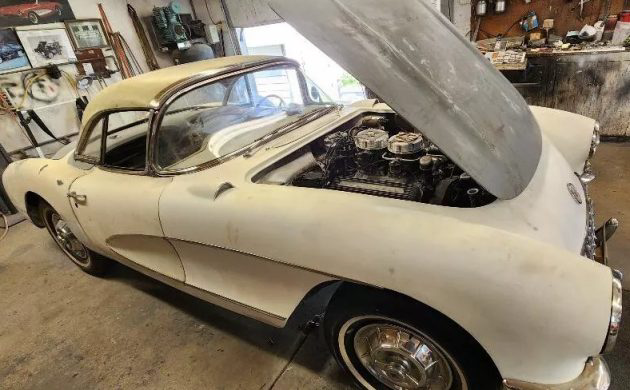
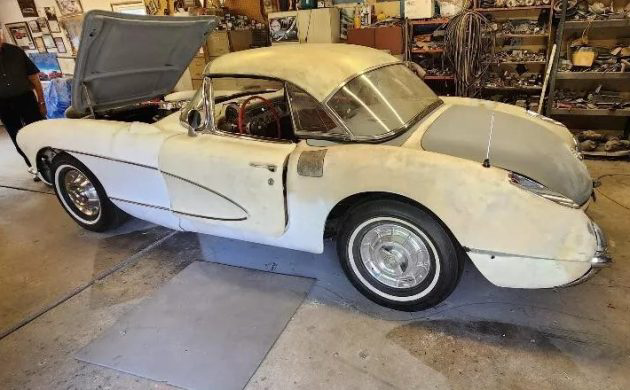
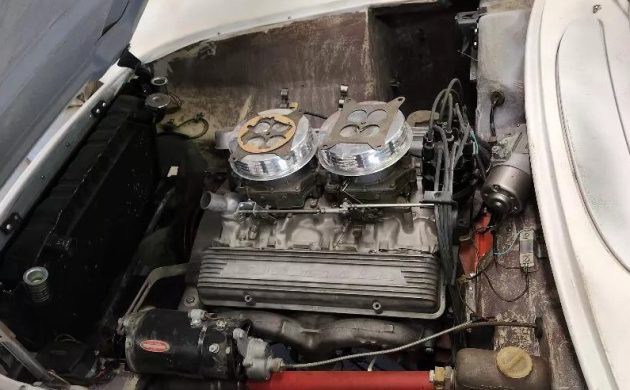
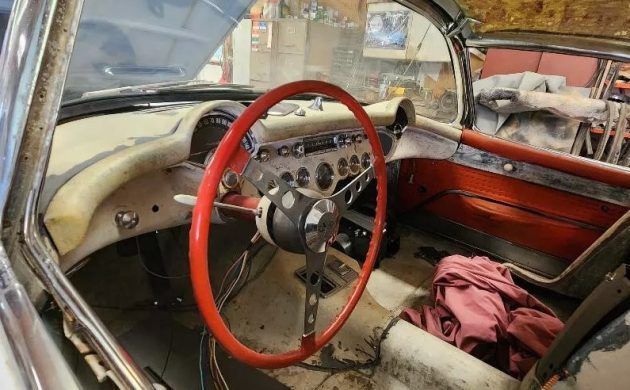
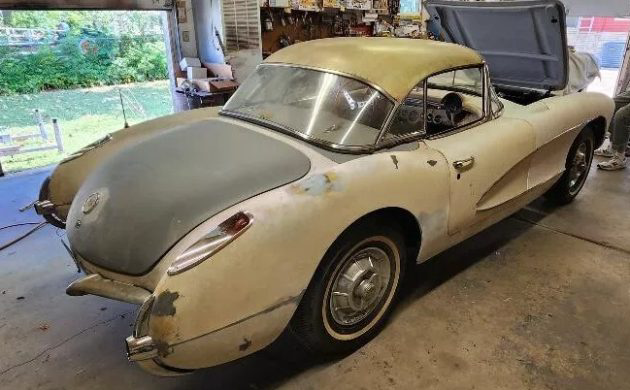


Enough of the price BS, let’s talk ’57 Corvettes, shall we? As the author mentioned, Corvettes had a slow start, simply because it was so unusual. The 2x4s were the top of the line, without going the F.I. route, that claimed 1 HP/cubic inch. Yeah, right. I miss the authors signature performance times not mentioned here, but this car did 0-60 in 6.7 seconds, the 1/4 mile was 15.4@95mph, but geared for top speed of 130 in under a minute. That, my friends, for 1957 was unheard of in a production car. So who bought these? This was no kids car, none that I knew anyway, more like a gas station owner that told everyone he drove Americas best. I bet more than once, old Gus( station owner) left the keys during lunch, and some kid pump jockey took the rear tries down some. Gus was cool, he knew all along, and that kid pump jockey grew up to be( leaning forward), why, it could have been any of us!
“Enough of the price BS,” Amen Brother Howard!!!! I am so tired of hearing these cars spoken about like they are gold bars or diamonds. Anybody thinking they could make a dime after restoring this car needs an intervention from those who care about him/her.
Making money is not the point about these cars. They are the American dream on wheels and they made an impact on the world. No other maker has produced a car that performs like a Corvette for the price of a Corvette. If I want investment advice I’ll read the Wall Street Journal, not Barn Finds.
Thanks Howard!
Thumbs up, the manual version,,,
Some years ago, I saw one of these at a NCRS show and fell in love. About 2 years later I found one in a barn in somewhat similar shape: the body had more cracks, but came with an uninstalled nicely rebuilt 283 and 4-spd transmission. The car had been raced in the 60s, and was not numbers matching. It was missing seats and various bits of trim. Restoring it to NCRS show quality was not practical, but making it a nice driver was doable. Most parts were available (repro or used) and affordable. There were some parts that were not reproduced and quite expensive, like the clock and rear deck latch. The car was a fun build and drove well….. The only problem was that it just wasn’t comfortable for me. I am a 2XL guy and the car was too small. I even fitted a smaller steering wheel and seats from a ’61 to get maximum room but to no avail. I kept it 2 years. I am sticking (mainly) to C2s.
The car here would be a fun DIY driver project for someone that will fit. As with my car, making it NCRS show quality will cost significantly more than it will ever be worth.
Restoring it to “NCRS show quality” would cost signifyingly more than it’s worth is a gross understatement. Restoring it to “driver quality” is very nearly out of the question given where the bidding is at now. I have owned Corvettes for most of my adult life, and I am particularly fond of ’57s, but sometimes things just don’t make any sense. I believe that this one of those times.
Charles, So true ” It doesn’t make sense” but it sure doesn’t stop most of us. Go figure!
Mildly delusional is what my wife says.
Well if you are worried about the cost to restore a classic then you not be shopping for one
Simply reading an add does not necessarily equate to “shopping” for the subject of the ad. Just as commenting on one is anything more than an opinion.
Dogwater sounds like he needs to go out again to pee. Someone open the door for him. Perhaps some training would help.
Looks like buyers remorse……this one’s been for sale before…..
I thought the same thing.
How come C1 Corvettes go from 1953 to 1962 when the 1953-55 models are styled different than the 1956-62? Shouldn’t 1953-55 be just C1’s and 1956-62 be C2’s? It seems to be a natural cut-off point.
Hi Mike, that’s a good question. I read, the ’61 was still considered a C1 because it had a straight front axle and live rear axle, like the original. It was considered the 1st generation.
A straight axel frontend?????
@Mike- C2 starts with the 1963 based on the independent rear suspension in place of the solid rear axle. !963 was also the first year of the 327 ci engines. And you know the story behind the SWC. That really was a generational change.
Error code! 327 was available in 1962. Shouda stuck to the C4’s!